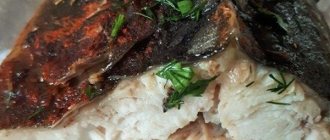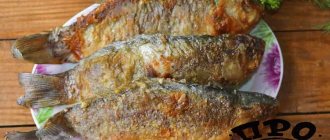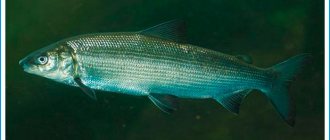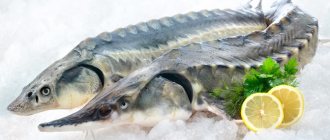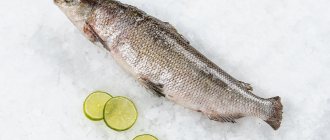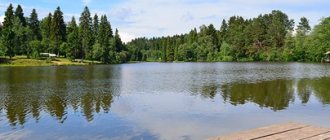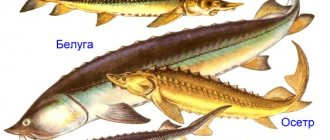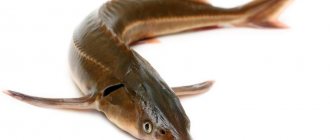Description, structure and characteristics
Sturgeon is a big fish. The body length of large species can reach about 6 meters. The maximum weight of the fish is 816 kilograms. This is exactly the body mass of the world's largest white sturgeon. But the average commercial fish weighs 12-16 kilograms.
The fish has a small head and an elongated snout, spatulate or cone-shaped. Retractable mouth, 4 antennae at the end of the snout. The lips are fleshy, the lower lip is torn, there are no teeth. The fry grow small teeth, but disappear over time. The gill openings of sturgeons are the same as those of sharks; regular gill rakers are located on their inner surface.
The sturgeon's skeleton consists of cartilaginous tissue, there are no vertebrae, the notochord is preserved throughout the life of the fish. The body is spindle-shaped and highly elongated. The fish has no scales, but its body is covered with five rows of special scutes-bugs - diamond-shaped bony scales. Each species of sturgeon is characterized by a certain number of bone bugs.
The sturgeon has a hard pectoral fin, its front ray, similar to a spine, is especially thick and pointed. As a rule, the age of the fish is determined by the transverse cut of the front ray. The dorsal fin has from 27 to 51 rays. The anal fin may contain from 18 to 33 sharp rays.
The sturgeon is most often gray in color. The color of the back can be light gray, light brown, grayish-black, yellowish or green. The fins are characterized by a dark gray tint, the sides are brownish, the belly is white, gray with blue or grayish with yellow.
Sturgeon is one of the long-living fish. On average, fish live 40-60 years, while the lifespan of some fish can reach 100 years.
Description of the species
Sevruga is a large sturgeon fish with an average weight of 3 to 10 kg and reaching a length of up to 1 m. There have been recorded cases of catching giant representatives of the species weighing more than 150 kg in weight and 2.2 m in length.
The standard placement of scutes for sturgeon is also observed on stellate sturgeon. The peculiarity of the structure of the bugs in this species is that the heat on the sides between their rows is covered with star-shaped plates.
Important! The number of bugs on the sturgeon is less than on the sturgeon: 14 dorsal, 36 lateral, 11 abdominal.
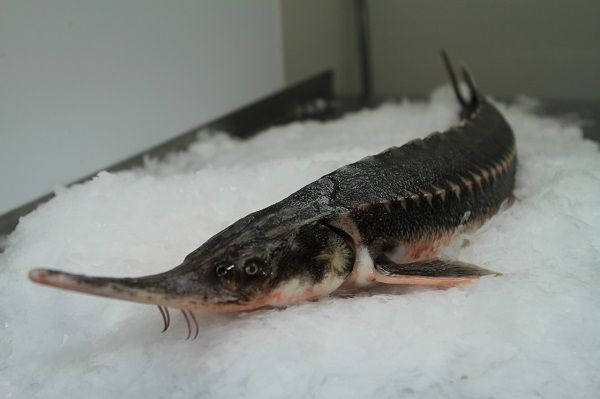
Another most characteristic detail in the appearance of the stellate sturgeon, which distinguishes it from other sturgeons, is its snout: it is long and narrow, occupying about 2/3 of the head.
The mouth, like all Sturgeons, is on the underside. It widens slightly closer to the gills. The lower lip of the fish is interrupted, the antennae are short, without fringe. There are 26 rakers on the first gill arch.
The dorsal fin has up to 46 rays, the anal fin has up to 29.
Population and species status
In the 21st century, the sturgeon is especially at risk of extinction, the reason for this is human activity: environmental degradation, overly active fishing, which continued until the 20th century, poaching.
The trend towards a reduction in the number of sturgeon became obvious back in the 19th century, but active measures began to be taken only in recent decades: to fight poachers, raise fry on fish farms and then release them into the wild. Today in Russia it is strictly prohibited to catch almost all types of sturgeon.
Fishing and fishing methods
Due to its excellent culinary qualities, it has been and remains the subject of industrial and amateur fishing. It is mainly mined in the Northern Caspian region, where 40 years ago at least 10 thousand tons of it were caught annually. A separate source of income has traditionally been the export of stellate caviar.
Over the past decades, the number of the stellate sturgeon species has decreased significantly and is currently even under protection. In sport and recreational fishing, stellate sturgeon fishing is carried out using various bottom gear. On an industrial scale, with nets and seines.
0
Author of the publication
offline 4 months
Types of sturgeon
In Russia, sturgeon live in places from the White Sea to the Caspian Sea. Fish are found in the basins of Siberian rivers, in the east - in the Pacific Ocean, in the west, sometimes in the Baltic Sea.
Amursky
It is found in the basins of the Amur River, including in floodplain lakes: Kizi, Boloni, Orel-Chle. The Amur sturgeon is distinguished by the presence of smooth gill rakers with 1 apex. An endangered species. The length of the Amur sturgeon reaches 3 meters and weighs about 190 kilograms, the average weight does not exceed 56-80 kilos.
Representatives of sturgeon are distinguished by their pointed, elongated snout. The fish feeds on larvae of mayflies, caddis flies, lampreys, various crustaceans, and small fish. During the spawning period, schools of fish go up the river to the Nikolaevsk-on-Amur region.
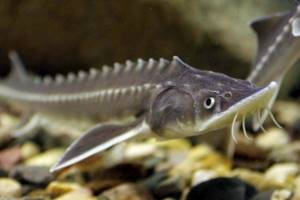
Kaluga
A fish belonging to the beluga genus. It is a large fish, the length of which reaches more than 4 meters and weighs up to 1000 kilograms. Kaluga is considered a long-liver, because with a weight of about 600 kilograms it can live up to 50 years. The diet includes fish: pink salmon, silver carp, carp, chum salmon. Small individuals feed on minnows and lampreys. Puberty occurs late - by 18-20 years.
Inhabits the Amur basin along its entire length. Found in Lake Orel, Ussuri. Does not go into the Sea of Okhotsk.

Atlantic (Baltic)
A large fish, the length of which can reach 6 meters. The maximum recorded weight of the fish is 400 kilograms. The Atlantic sturgeon has large bugs and has three pairs of large fused scutes on its tail. The back color of the Atlantic sturgeon is grayish-olive, the sides are lighter than the back, and the belly is white.
The habitat is the Black Sea and the Bay of Biscay, where no more than 300 individuals are found. A small number of fish are found only in France in the Garonne River.
The Atlantic sturgeon prefers to feed on small fish (gerbil, capelin, anchovies), worms, crustaceans and mollusks.
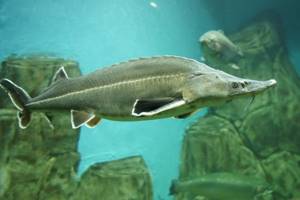
Stellate sturgeon
A large fish, the length of which reaches 2.2 meters and weighs about 80 kilograms. It is characterized by an elongated, narrow, slightly flattened snout. The back of the sturgeon is black-brown, the belly is white, the sides are lighter than the back.
Stellate sturgeon prefers to feast on mysids, crustaceans, various worms and small fish. The stellate sturgeon lives in the basins of the Black, Azov, and Caspian seas. During the spawning period, the fish goes to Kodori, Volga, Inguri, Ural, Southern Bug, Kura, Dnieper, Kuban, Don.
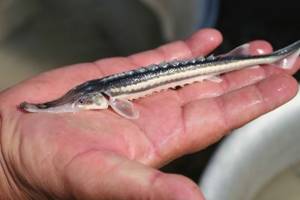
Sterlet
The natural habitat of the sterlet is the rivers of the Baltic, Black, and Azov seas. Fish is found in the following rivers: Ural, Dnieper, Sura, upper and middle Kama, Yenisei, Irtysh, Ob, Volga, Don. Previously, sterlet was found in Lakes Onega and Lake Ladoga. The fish is considered a vulnerable species.
Sterlet is a medium-sized fish. Puberty occurs early: males are ready for spawning at the age of 4-5 years, females - at 7-8 years. Another difference between the sterlet and other sturgeons is the presence of fringed antennae and a large number of lateral bugs: there are more than 50 of them.
Sterlet is a freshwater fish, but there are few semi-anadromous forms. The maximum length of the sturgeon variety reaches 1.25 meters and weighs 16 kilograms. The average size of a sterlet is 40-60 centimeters. The snout of the fish is sharp or blunt, the color varies from brownish-gray to brown. The belly is white with yellowish tint.
Sterlet feeds on insect larvae, leeches, other bottom organisms, and small fish in small quantities. A valuable hybrid form of sterlet and beluga is bester.

Read about breeding sterlet at home here.
Thorn
The advantage of the sturgeon is that it thrives equally well in both fresh and salt water, due to which its habitat extends over many kilometers. Representatives of this species are found in the Black, Caspian, Azov, Aral Seas, and in river basins adjacent to these reservoirs. Many individuals live in the Sefidrud River, the Urals, and the Kura.
Adult spiny fish can reach more than 2 meters in length, but many representatives of this species are smaller. The spine is characterized by an elongated body with cone-shaped spines on the back. Unlike other representatives of sturgeon, the sturgeon has fringed antennae located near the lower lip.
The color of the thorn varies from light gray to greenish, the belly is light. There are star-shaped scales on the surface. Thorn is a fish listed in the Red Book of Russia.
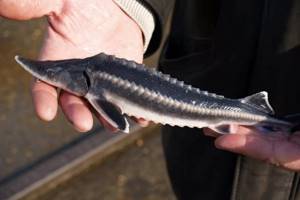
Ozerny
The lake sturgeon is a large fish with a blunt snout. The maximum size officially registered is 2.74 meters with a weight of 125 kilograms. The sturgeon's body color can be greenish-brown, black with a gray tint. The belly is white or slightly yellow.
The diet of the lake sturgeon includes all kinds of bottom microorganisms; the sturgeon feeds less often on fish. The fish's habitat is the Great Lakes system, Lake Winnipeg, and the basins of the Saskatchewan, Mississippi, and St. Lawrence rivers.
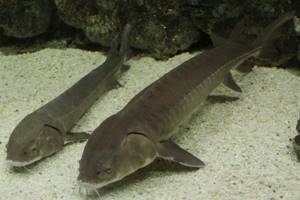
Russian (Caspian-Black Sea)
A valuable species of sturgeon, which has gained popularity due to the exceptional gastronomic qualities of its meat and caviar. An endangered species. The fish has a blunt, short snout and antennae growing towards the end of the snout. The maximum length of an adult reaches about 2.36 meters and weighs 115 kilograms. But usually the weight of Russian sturgeon is 12-24 kilograms with an average length of 1.45 meters. The color of the back is grayish-brownish, the sides are with a yellow tint, and the belly is white.
The Russian sturgeon lives in all major water areas of Russia. Found in the basins of the Caspian, Azov and Black Seas. During the spawning period, fish go to the Mzymta, Psou, Volga, Rioni, Terek, Danube, Don, Dnieper, Kuban, Samur and other rivers.
Depending on the habitat, the diet of representatives consists of worms, mysids and amphipods. Russian sturgeon prefers to eat fish: shemaya, mullet, herring, sprat. Under natural conditions, the sturgeon produces hybrid offspring with thorn, stellate sturgeon, sterlet and beluga.
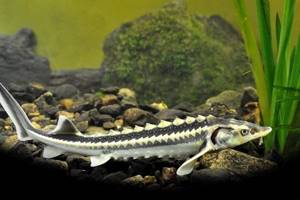
Persian (South Caspian)
The Persian sturgeon is an anadromous species that is a close relative of the Russian sturgeon. Conservation status: critically endangered. The maximum size of a sturgeon is 2.42 meters and weighs 70 kilograms. Representatives are characterized by a large, long, slightly curved snout and a gray-blue back, blue sides with a metallic tint.
The fish's diet consists of benthos and small fish. Sturgeon is found in the middle and southern regions of the Caspian Sea, areas of the Caspian Sea and off the Black Sea coast. During spawning they go to the Rioni, Volga, Enguri, Ural, Kura.
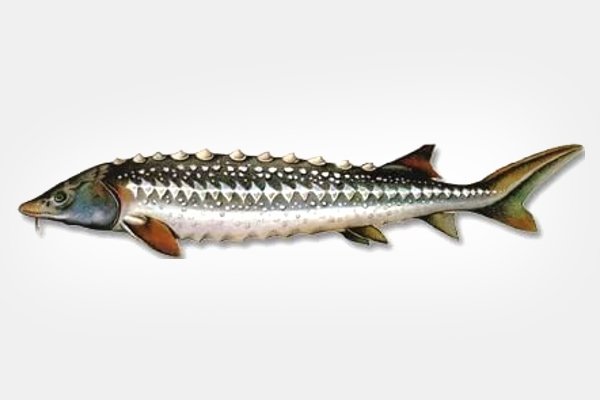
Beluga
A large fish, the weight of which can reach 1500 kilograms and a length of more than 4 meters. The fish's snout is similar in appearance to that of a pig. The mouth is large, sickle-shaped, the lips are thick. The eyes are small and blind. The body is covered with large scales. The back is grayish-brown in color, the belly is light, almost white.
Beluga lives in the Black, Azov and Caspian seas. Rarely found in the Adriatic Sea. It goes to spawning in the Dniester, Volga, Dnieper, Don, and Danube. Slightly less common in the Terek, Ural or Kura rivers.
Beluga fry feed on river plankton, caddis and mayfly larvae, eggs and fry of other fish. Having matured, the fish eat juvenile sturgeon and stellate sturgeon, crustaceans, mollusks, gobies or sprat, carp and herring.
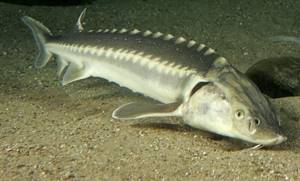
Sakhalin
A rare species of sturgeon. The average length of adult individuals reaches 1.5-1.7 meters and weighs 35-45 kilograms. The largest individuals can reach up to 2 meters and weigh about 60 kilograms. Adult Sakhalin sturgeons have a large, blunt snout and a greenish-olive color.
Sturgeons feed on various bottom inhabitants: snails, insect larvae, small shrimp, mollusks, crustaceans, and small fish.
The habitat covers the cold waters of the Seas of Japan and Okhotsk, the Tatar Strait. The sturgeon goes to spawn in the Tumnin River, located in the Khabarovsk Territory.
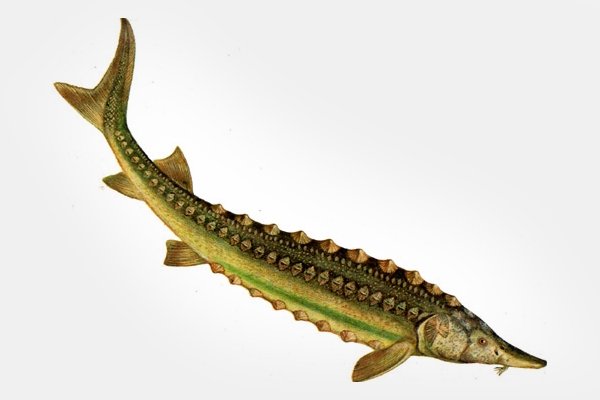
Description
Stellate sturgeon belongs to the sturgeon family, and its appearance is radically different from any other fish. Sevruga has a very long nose, occupying almost 2/3 of the length of the entire head. Short antennae are located around the mouth. There are about 50 rays in the dorsal fin, and from 22 to 35 in the anal fin.
There are star-shaped plates on the sides of the fish, which also distinguish it from other sturgeon. The belly of the fish is white and the sides are light, but the back has a brown or black tint. The upper lobe of the tail is usually larger than the lower one.
This fish is larger than sterlet, however, it does not reach the same size as sturgeon or beluga. Most often, it grows to a weight of 7-10 kilograms, but individuals over 2 meters in length and weighing more than 80 kg have also been encountered. However, this was a distant evidence, and already in the 20th century the largest trophy reached 54 kg. As with other sturgeons, stellate sturgeon can be considered a long-lived fish. She often lives to be 35 years old.
Habitats, migrations and distribution
Sturgeons are freshwater, anadromous and semi-anadromous. Migratory fish are those that live in the sea and then in rivers. During spawning, they migrate from the sea to rivers or vice versa, which is much less common. Semi-anadromous fish are a group of fish that live in coastal zones of seas or in sea-lake areas. During spawning they migrate to the lower reaches of rivers.
The natural habitat of the sturgeon passes through the water bodies of the Northern temperate zone of Europe, northern Asia and North America. Over millions of years of evolutionary development, the sturgeon has adapted well to living in a temperate climate zone; the fish tolerate low water temperatures well and can go hungry for a long time.
Sturgeon is a bottom-dwelling fish, swimming at depths from 2 to 100 meters. Migratory species of sturgeon live in the coastal waters of seas and oceans, but they spawn in fresh river water, where the fish enter by swimming against the current, covering impressive distances. After breeding, schools of fish go back to the sea.
Semi-anadromous species of sturgeon live in the salty coastal waters of the seas and oceans, spawning at the mouths of rivers, without going upstream. Many freshwater species of sturgeon do not undergo long migrations; they prefer to lead a sedentary lifestyle in the waters of rivers and lakes, where they feed and reproduce.
All sturgeons spawn in the spring and summer, but migrate to the spawning grounds at different times. Because of this, sturgeon are divided into seasonal races - winter and spring. Spring birds go to breeding grounds before spawning, in the spring. Winter crops - in the autumn, when the eggs have not yet ripened.
Origin of the species and description
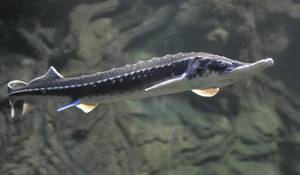
Photo: Sevruga
The common name for this species is “star sturgeon.” The scientific name "stellatus" is a Latin word meaning "covered with stars." This name refers to the star-shaped shape of the bony plates covering the body of this animal.
Video: Sveruga
Sturgeons, to which the stellate sturgeon belongs, are one of the oldest families of bony fish, native to subtropical, temperate and subarctic rivers, lakes and coastlines of Eurasia and North America. They are distinguished by their elongated bodies, lack of scales and rare large size: sturgeons 2 to 3 m long are common, and some species grow up to 5.5 m. Most sturgeon are anadromous bottom feeders, spawning upstream and feeding in river deltas and river mouths Although some are entirely freshwater, very few reach the open ocean beyond coastal areas.
Stellate sturgeon swims in temperate freshwater, brackish and sea waters. It feeds on fish, mollusks, crustaceans and worms. It mainly lives in the basins of the Black and Caspian Seas and the Sea of Azov. The largest population is in the Volga-Caspian region. There are two different spawning cycles for this species. Some fish spawn in winter and some in spring.
Spawning
Puberty in sturgeon occurs between the ages of 5 and 21 years. Females spawn approximately once every 3 years, several times during their lives, males - more often. Spawning of various sturgeon fish can take place from March to November. Peak spawning occurs in mid-summer.
A prerequisite for a successful reproduction process and further maturation of the offspring is freshness of water and a strong current. Sturgeons will not be able to reproduce in stagnant or salty water. The temperature of the water is also important; the warmer it is, the worse the caviar will ripen. Embryos will not be able to survive when heated to 22 degrees.
During one spawning, female sturgeon are capable of throwing up to several million eggs, the diameter of which ranges from 2 to 3 millimeters, and their weight is up to 10 mg. Females lay eggs into crevices of the river bottom, into cracks in large boulders, and between stones. Sticky eggs adhere firmly to the substrate, due to which they are not carried away by river currents. Embryos develop from 2 to 10 days.
Spawning (reproduction)
It begins to reproduce later than other sturgeon species. As a rule, the spawning run begins at water temperatures from 6 to 9 degrees, in mid-April and the first ten days of May. Males reach sexual maturity only at 7-9 years of age, and females not earlier than 11 years of age. As for fertility, on average an adult Volga fish can contain from 106 to 470 thousand eggs; in the Don and Ural species this range can be even wider.
In the Volga River, stellate sturgeon spawning extends from May to August at a temperature range of 12 to 26 °C. The eggs are spawned small, dark gray in color, no more than 2 mm in diameter. It has a light iodine odor and delicate taste.
What does sturgeon eat?
The sturgeon prefers to feast on various bottom organisms and fish. The composition of the diet directly depends on the age of the fish and its habitat:
- Sturgeon fry prefer zooplankton (Daphnia, Bosminamia, Cyclops), but can feed on very small crustaceans and worms.
- Juveniles feast on insect larvae, small shrimp, snails and crustaceans. In the stomachs of fry there are often inedible particles, most likely absorbed from the muddy bottom.
- An adult eats 85% protein foods. Sturgeons become especially voracious before breeding: they eat almost everything they can find on the bottom, including various crustaceans (usually amphipods) and representatives of the order Cladocera. They love to feed on the larvae of insects, caddis flies, and mosquitoes. They feast on clams, mussels, leeches, shrimp, and worms.
When the amount of protein food is limited, sturgeons eat algae. The fish diet consists of sand lance, herring, sprat, gobies, anchovies, sprat, pike perch, silver bream, mullet and other types of small and medium-sized fish.
During the spawning period and after the breeding process, the sturgeon stops feeding and switches to eating vegetation. Within a month, the fish recovers, its appetite returns, after which it again goes in search of food for further survival.
Biology[edit | edit code]
Migratory bottom fish[4]. Stellate sturgeon feeds on invertebrates (crustaceans, worms) and fish (gobies, herring and sprat). In the Northern Caspian Sea, the diet of juveniles up to 10 cm long consists mainly of amphipods; with a length of 10 to 29 cm from nektobenthos (mysids); with a length of 30-40 cm from fish. In the Middle Caspian, the basis of the diet, regardless of age, is crustaceans (amphipods, cumaceans and mysids); fingerlings up to 20 cm long feed exclusively on amphipods; At the age of 4 years, stellate sturgeon begin to eat fish. The diet of adults includes crustaceans (crabs, mollusks, polychaete worms) and fish. Sevruga caviar serves as food for thorns, sterlet, barbel, bleak, gudgeon, char, and silver bream. In places where juveniles are released from fish factories, they are preyed upon by catfish[4].
It was possible to obtain viable hybrids: sterlet X stellate sturgeon and stellate sturgeon X sterlet[5], thorn X stellate sturgeon[6].
Reproduction and life cycle[edit | edit code]
Spawns in rivers. In terms of timing, the course of stellate sturgeon in the Volga, Ural, and Terek is approximately the same. Stellate sturgeon enters the Kura all year round, in smaller quantities in cold winters and hot summers. Spawning in the same places where sturgeon spawns, in addition, in turfy areas of the banks that are temporarily flooded by flood waters. Spawning begins in May at a water temperature of +15 °C, peak at +18 - +20 °C[4].
Fertility 58.8 thousand (female 10 years old from the Urals), 416 thousand eggs (female 19 years old). The average fecundity in the Urals is 198.5 thousand, in the Volga - from 218 to 238 thousand eggs [4].
Natural reproduction has been preserved in the Urals. In other rivers, reproduction is based on hatchery rearing of juveniles. Sturgeon hatcheries are located in the lower reaches of the Kura (1954), Volga (1955) and Pahlavi (1971, Iran)[4].
The eggs are bottom-based and adhere to the substrate.
The egg diameter is 2.8–3.0 mm. Development lasts from 44 to 80 hours. At spawning grounds, a large mass of eggs is eaten by fish. The larvae roll into the sea, a small part of the juveniles linger in the river. In the Volga, the rolling larvae have a length of 30-85 mm, in the Kura - 21-123 mm. In factories, caviar develops in a deglued state[4]. Linear growth of sturgeon before puberty[4]
| Age | Fingerlings | 1 | 2 | 3 | 4 | 5 | 6 |
| Absolute length, cm | 12—29 | 22—39 | 31—54 | 40—67 | 54—77 | 68—80 | 77—86 |
| Average length, cm | 19,3 | 29,8 | 43,7 | 55,1 | 64,2 | 75,5 | 81,9 |
Time of onset of sexual maturity in the stellate sturgeon of the Caspian basin
| River | Age at puberty, years | |||
| minimum | mass ripening | |||
| males | females | males | females | |
| Ural | 4 | 8 | 7—9 | 11—13 |
| Volga | 7 | 7 | 9—12 | 11—15 |
| Kura | 8 | 8 | 10—13 | 12—15 |
Migrations[edit | edit code]
Stellate sturgeon regularly migrates to feeding areas, in the spring to the north and to the coastal strip, and back in the fall. The stellate sturgeon comes to spawn in the Urals at a water temperature of +5.4 - +7.2 °C. Initially, males predominate in the catches; at the height of the run, the number of males and females is approximately the same. Peak season is in May. At the end of May, individuals arrive that differ from the early spring ones. In mid-June, when the water level in the river drops sharply, the peak of the late spring stellate sturgeon season is observed. The course ends in June. In the Volga delta, stellate sturgeon begins to spawn in early April at a water temperature of +3 - +9 °C. The peak of the run in the lower reaches is the end of April-May, above the delta - June. The stellate sturgeon enters the Kura all year round, with two peaks observed: in April-May and October-November. In the Kura stellate sturgeon also occurs in early and late spring[4].
Sturgeon caviar
Sturgeon caviar is one of the most elite and expensive delicacies in the whole world. The cost of 1 kilogram of product often reaches up to 6 thousand dollars. The high price of fish is due to the annual decline in their population. Taking into account that industrial fish production is prohibited in many countries, the main suppliers of the product are artificial fish.

Real black caviar has a refined, lightly salted taste with a slight aroma of seaweed. The color of caviar varies from light gray to dark brown. Due to the high cost of the product and its unique color, caviar was called “black gold”.
The delicacy is used as a cold appetizer with sparkling wine, vodka and dry champagne. The delicacy is served pure in crystal vases or in turtle shells with small silver spoons. Many people prefer to make sandwiches with butter and caviar. The product is also combined with onions, hard cheese, vegetables, eggs and herbs.
To prevent caviar from losing its unique taste and attractive appearance, it is served 15 minutes before consumption. Until this point, the snack is stored in the refrigerator. In addition to its excellent gastronomic properties, sturgeon caviar is especially valued in natural medicine. It contains at least 30% easily digestible proteins, 12% fatty acids, 6% vitamins and mineral salts.
It is useful to use caviar for the following problems:
- atherosclerosis;
- iron deficiency anemia;
- nervous system disorders;
- chronic fatigue;
- osteoporosis.
It is useful for pregnant women and breastfeeding mothers to eat sturgeon caviar, due to the vitamin E and choline it contains. It is recommended to consume the product during the post-rehabilitation period (after operations) - it has a general strengthening effect.
To get maximum benefit from the product, only high-quality caviar is consumed.
Economic importance
Stellate sturgeon is a valuable commercial fish, whose numbers are declining. They are caught using smooth nets and cast seines. Stocks are maintained through artificial reproduction in fish hatcheries. The meat has a particularly high taste. It is prepared chilled and frozen, and the eggs are used to prepare pressed and granular caviar, often mixed with caviar of other sturgeons.
Listed in the IUCN Red List.
Literature: 1. N. Svetovidov. Fishes of the Black Sea. Moscow-Leningrad, 1965 2. L. S. Berg. Freshwater fish of the USSR and neighboring countries. Part 1. Edition 4. Moscow, 1948 3. Lebedev V.D., Spanovskaya V.D., Savvaitova K.A., Sokolov L.I., Tsepkin E.A. Pisces of the USSR. Moscow, Mysl, 1969 4. Fishes of the north of the Lower Volga region: In 3 books. Book 1. Composition of ichthyofauna, methods of study / E.V. Zavyalov, A.B. Ruchin, G.V. Shlyakhtin and others - Saratov: Sarat Publishing House. Univ., 2007. - 208 p.: ill. 5. Fishes of Kazakhstan: In 5 volumes / Mitrofanov V.P., Dukravets G.M., Peseridi N.E. et al. - Alma-Ata: Science, 1986. T. 1. Lampreys, Sturgeons, Herrings , Salmonidae, Pike. — 272 p.
Breeding and rearing
In nature, many species of sturgeon fish easily form crosses, due to which a hybrid of sterlet and beluga - bester - was artificially bred for commercial cultivation. Today, many people are increasingly resorting to breeding sturgeon at home. If all stages of the technological process are followed, it is possible to obtain products that will be no worse in quality than livestock caught in natural reservoirs.
Features of cultivation (subject to permission from the state):
- To grow sturgeon, you will need to select a plot of land whose area will be at least 30 square meters. It is recommended to choose a location away from roads, because sturgeons are shy fish. It is very important to take care of heating in winter.
- Professional sturgeon farming on a large scale requires about 5-7 tanks where adult fish will be sorted. But beginning breeders can use one small container, 2-3 meters in diameter and at least 1 meter deep. Such a pool will allow you to grow about 1 ton of fish.
- For good fish growth, filters, pumps, compressors, and pipelines are installed in the pools. It is advisable to purchase an automatic feeder and incandescent lamps. When using plumbing to supply water, the fish farmer must ensure that no residual chlorine enters the pool. The volatile compound can be eliminated by installing a carbon filter.
- Take care of the fish regularly. Be sure to keep the pool clean: change 10% of the water daily, remove silt from the walls, monitor the temperature and serviceability of the equipment. The optimal water temperature in cold weather should be at least 17-18 degrees, in summer – 20-24 degrees.
- It is difficult to calculate the rate of future growth of the fry, so the fish are sorted weekly into different tanks. At the same time, the cultivation of strong specimens takes no more than six months, medium – 7 months, strong – up to 9 months.
Successful sturgeon breeding directly depends on the nutrition of the individuals. They are fed nutritious high-calorie food, which should contain the following components:
- protein – at least 45%;
- crude fats – 25%;
- dietary fiber – 2%;
- phosphorus and lysine – 1%.
When choosing food for sturgeon, it is recommended to give preference to water-resistant food that swells and sinks in water. Fry are fed 5-6 times a day, adults - 4 times a day. At the same time, equal time intervals must be maintained between feedings, otherwise the fish may refuse to eat.
Read more about sturgeon breeding here.
Development of stellate sturgeon
Embryonic development at the lowest temperatures (15°C) lasts about 6 days. At a temperature of 25°C, embryos hatch after 55-60 hours. The first migrating prelarvae and stellate sturgeon larvae (5-17 mm) in the Ural delta appear in the second or third ten days of May. Simultaneously with the larvae, juveniles that have switched to active feeding (43 mm) are also caught. The transition of stellate sturgeon larvae to active feeding begins on the 5-9th day after hatching at a length of 18-19 mm. Benthic organisms at the earliest stages of development, the size of which are 1-2 mm, are used as food, oligochaetes, polychaetes, corophyids, gammarids, mysids, larvae and pupae of chironomids (in the spawning zone). In the first ten days of June, the average length ranges from 21-43 mm with an average weight of 88-307 mg.
Mass migration usually continues throughout June. The average weight of juveniles by the end of the month reaches 1.2-1.3 g. Having rolled into the sea, juvenile sturgeon stays for a short time in the desalinated estuary space, and then begins to disperse throughout the sea.
The benefits and harms of sturgeon
Sturgeon is rich in easily digestible proteins, due to which the product is quickly digested and is often recommended by nutritionists for various diets. The composition of sturgeon meat is rich in rare beneficial acids, including glutamic acid, as well as vitamins A, C, PP and group B. Sturgeon meat is a delicious product that contains useful macro- and microelements: potassium, fluorine, phosphorus, iodine, calcium, nickel , magnesium, molybdenum, sodium, chromium, iron, chlorine. The calorie content of sturgeon is 160 calories per 100 grams of product.
The calorie content of 100 grams of sturgeon caviar is about 200 calories. The product is rich in healthy proteins and lipids. It is useful to eat caviar for people who are in poor health after a serious illness and for those who have undergone aggressive treatment.
With regular consumption of sturgeon, which contains healthy fatty acids, blood vessels and heart muscles are strengthened, which helps lower cholesterol levels in the blood and reduce the risk of myocardial infarction. Caviar has a beneficial effect on the growth and strengthening of bone tissue and improves skin regeneration.
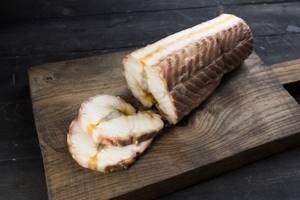
Consumption of sturgeon caviar and fish meat has a beneficial effect on human health and well-being:
- Sturgeon fat helps improve brain function and strengthen the cardiac and vascular systems.
- When consumed, fish fights stress and depression.
The most valuable caviar is stellate sturgeon, beluga and Russian sturgeon. The product differs in color and size.
The danger for humans is that sturgeon caviar and meat itself can be contaminated with botulism pathogens. Because of this, fish are purchased only from reliable suppliers. When purchasing, a thorough visual inspection of the product is carried out.
People suffering from diabetes and obesity should consume fish carefully to avoid the risk of deterioration in health.
List and photos of popular sturgeon fish
Sturgeons are the most popular in fishing. To date, about 20 species of representatives of these fish . The most popular are sturgeon.
Beluga is the oldest species of freshwater sturgeon. The life cycle of this fish can reach up to 100 years. Beluga can grow up to 10 meters in length and weigh 3 tons. The body of the beluga is shaped like a torpedo, and is covered in 5 rows of bony protective plates, white below and gray above. At the bottom of the muzzle there is a sickle-shaped mouth and antennae, which provide the fish with a sense of smell. Females are larger than males. Beluga is a predatory fish that usually feeds on gobies, anchovies, anchovies, roach and herring. Females lay eggs in the spring, once every 3-5 years.
Kaluga . This is a freshwater fish of the beluga family. The size of kaluga can reach up to 5.5 m, and body weight up to one ton. The mouth is semilunar and large. This fish is widespread in the Amur basin, and can also be found in the Sungari, Shilka, Arguni. They distinguish fast-growing, estuary, anadromous kaluga.
Russian sturgeon . It has a spindle-shaped body with a small, blunt snout. The antennae are at the end of the mouth. Typically, the Russian sturgeon is black and gray on top, brown and gray on the sides, and has a white belly. The fish reaches a maximum size of up to 3.5 m in length and can weigh up to 120 kg. The life cycle reaches up to 60 years. In its natural environment, sturgeon can create crosses with beluga, sterlet, stellate sturgeon and thorn. This does not happen very often, but these hybrids do come across. Habitat: Black, Caspian and Azov seas.
Shovelnose . Freshwater fish weighing up to 4.5 kg and measuring up to 140 cm. It is distinguished by a flattened and rather long caudal peduncle with bony plates. The tail filament is small or completely absent, the eyes are small, and the swim bladder is large. Habitat: tributaries of the Amu Darya.
Siberian sturgeon . The body of this species of sturgeon is covered with multiple bony plates and fulcra, the mouth is retractable, and there are no teeth. There are 4 antennae in front of the mouth. Places of residence: basins of the Ob, Yenisei, Kolyma and Lena. The sturgeon reaches a maximum length of up to 3.5 m, weighs up to 150 kg, and has a life cycle of up to 50 years. Spawning usually occurs in July. The fish's nutritional base is provided by organisms that live at the bottom of the reservoir: amphipods, mollusks, chironomid larvae and polychaete worms.
Thorn . Has a general appearance for sturgeon. Of the 5 rows of bone spines, the dorsal one has 12-16 spines, the ventral one has 11-18, and the lateral one has 51-71. There are 22-41 gill rakers on the first gill arch. Places of residence are the basins of the Aral, Caspian, Azov and Black Seas.
Sevruga . Lives in the Caspian, Black and Azov seas. This species of sturgeon can be spring or winter. The elongated body shape of this fish is characterized by the presence of a poorly developed lower lip, a convex forehead, a long nose, and smooth and narrow antennae. The top and sides of the sturgeon's body are densely covered with bony scutes. The sides and back are blue-black, and the belly is white. Stellate sturgeon can reach a length of up to 6 m and weigh up to 60 kg.
Sterlet . The smallest fish among the sturgeon family, the sterlet can reach a length of up to 1.20 m and weigh up to 20 kg. The fish has long antennae reaching to the mouth, a narrow elongated nose, a lower lip divided in two and touching scutes on the sides. In addition to the usual plates on the body for sturgeon, the sterlet has closely touching scutes on its back. Depending on where they live, the sterlet can have a different color, but usually its back has a gray-brown tint, and its belly is yellow-white. All fins are gray. At the same time, the sterlet can be sharp-nosed or blunt-nosed. The fish lives only in the north of Siberia.
Fishing for sturgeon is against the law
According to paragraph 1 of Article 258.1 of the Criminal Code of the Russian Federation, fishing for sturgeon listed in the Red Book is prohibited. Species of sturgeon that are not included in the list of endangered fish cannot be fished during spawning (we are talking about recreational fishing). But more and more often there are reports in news feeds that it is prohibited to catch sturgeon (regardless of the species) almost everywhere. This indicates a critical decline in the number of sturgeon in the world.
Species of the Red Book sturgeon
There are nineteen species of fish that are included in the sturgeon family, and most of them are found in Russia. Most often, sturgeon is found in the Caspian, Azov and Black Seas, as well as in rivers in the North of Russia and the cold waters of the Sea of Japan and Okhotsk.
So, sturgeon is listed in the Red Book of the Russian Federation:
- Amursky;
- Atlantic;
- Sakhalinsky;
- Siberian;
- Russian.
Such specimens of the sturgeon family as sterlet, stellate sturgeon, thorn, kaluga and beluga are also in the Red Book of Russia.
The International Union for Conservation of Nature and Natural Resources (IUCN) list of critically endangered fish also includes sturgeon:
- Blunt;
- Korean;
- Adriatic;
- Persian;
- Chinese;
- White.
What threatens violators?
Only those species of sturgeon that are listed in the Red Book fall under Article 258.1 of the Criminal Code. Catching Red Book species of fish is punishable throughout the year, and not only during the period of protective measures during spawning or migration.
If brought to criminal liability, they face correctional labor for up to 2 years, forced labor or imprisonment for up to 4 years and a fine of up to 1 million rubles.
For posting on the Internet evidence of their catch of Red Book sturgeon, the offender is given up to 6 years in prison + a fine of up to 2 million rubles.
If the crime is committed by a group of persons, then the fine will be up to 2 million rubles and imprisonment for 5-8 years.
Where does the sturgeon live?
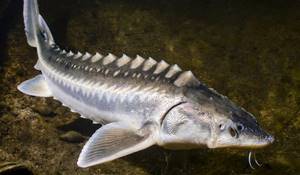
Photo: Sevruga in Russia
Stellate sturgeon lives in the Caspian, Azov, Black and Aegean seas, from where it enters tributaries, including the Danube. This species is rarely found in the Middle and Upper Danube, only occasionally the fish migrate upstream to Komárno, Bratislava, Austria or even Germany. This species is found in small quantities in the Aegean and Adriatic Seas, as well as in the Aral Sea, where it was introduced from the Caspian Sea in 1933.
During spawning migrations, the stellate sturgeon also found its way into tributaries of the Lower Danube River, such as the Prut, Siret, Olt and Zhiul rivers. In the Middle Danube, it migrated to the Tisa River (up to Tokaj) and to the lower reaches of its tributaries, the Maros and Körös Rivers, as well as to the mouth of the Zagywa River, the lower reaches of the Drava and Sava Rivers and the mouth of the Morava River.
As a result of regulation and damming of rivers, the range of stellate sturgeon in the catchment areas of the Caspian, Azov and Black Seas has been significantly reduced. The area of spawning grounds has decreased significantly, and migration routes and timing have changed. Currently, most individuals in the Danube River migrate only as far as the Iron Gate dams.
Stellate sturgeon is usually found in shallow waters of the sea coast and in flat areas of rivers. Small benthic animals are the main food source for adults, and plankton play an important role in feeding during the early larval stages.
Now you know where the stellate sturgeon lives. Let's find out what this fish eats.
Interesting Facts
Sturgeon is one of the oldest and most popular fish on earth. Archaeological finds dating back to 3 thousand years BC indicate that already in those days sturgeon caviar was successfully used by sailors in canned form. In the army of Alexander the Great, sturgeon caviar served as food for soldiers.
In the 20th century, one French woman managed to notice that women who process sturgeon caviar, despite their hard work, have very beautiful and smooth skin on their hands. After this, they began to study the miraculous properties of black caviar and launched a line of cosmetics, which enjoyed incredible success. Today they have stopped producing such cosmetics due to the fact that it is not profitable.
In the middle of the 20th century, an Atlantic sturgeon weighing 213 kilograms was caught in the Neva, and 80 kilograms of caviar were obtained from it.
Sturgeon is a unique fish that has gained popularity for its large size, elongated body and amazing exterior. All sturgeon fish are in great demand, because the value of their healthy meat is very high. You can earn a huge fortune not only by selling meat, but also sturgeon caviar.
0
0
Copy link
Structure and skeleton of sturgeon fish
Representatives of the sturgeon family have an elongated body shape, on which there are 5 rows of hard spines formed by bone tissue. Two rows are in the belly area, two more rows are on the side, and the last row is on the back. The spaces between the rows are filled with bone plates that perform a protective function.
Sturgeons are characterized by an elongated and cone-shaped snout, which has the appearance of a shovel. On the lower part of the snout there is a mouth with four whiskers and fleshy lips. The jaw itself has a retractable shape, but there are no teeth on it.

The fin on the chest has the shape of a spike with a thickening, and the fin on the back is shifted closer to the tail. The swim bladder is connected to the esophagus and is located below the spine. The most notable feature of sturgeon is the presence of a cartilaginous and invertebrate notochord instead of a skeleton. In the throat area of the fish there are membranes of 4 gills, as well as 2 accessory gills.


